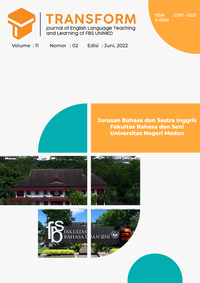Taboo Words in End of Watch Movie
DOI:
https://doi.org/10.24114/tj.v11i2.43999Keywords:
Taboo Words, Jay’s Theory, End of Watch Movie.Abstract
This research attempts to find out the types of the taboo words expressed by characters in End of Watch Movie by identifying it and to explain the motives for taboo words expressed by the characters in the End of Watch Movie. This research utilized a theory from Jay (1992). This research utilized a design of a descriptive method which is a method for research that endeavors to depict and interpret the articles as per reality. The data of this research are in the linguistic features found in the movie. The data are quantities of English taboo words that contain transcripts in the movie. The data in this research were collected by using documentary techniques. In order to collect data, recorder technique is used as the instrument to collect the data. The technique of analyzing data will be examined by utilizing descriptive qualitative methods. The results of the research show that there are 113 data and for the taboo words type of scatology is the frequently used by the characters with the rate 23,89% and the most motive used is anger and frustration with the rate 30,09%.Downloads
Published
2023-06-05
Issue
Section
Articles
License
Copyright (c) 2023 Mikhael Manahan Simamora, I Wayan Dirgeyasa Tangkas

This work is licensed under a Creative Commons Attribution-ShareAlike 4.0 International License.
Authors who publish with this journal agree with the following terms:
- Authors retain copyright and grant the journal right of first publication with the work simultaneously licensed under a Creative Commons Attribution License that allows others to share the work with an acknowledgment of the work's authorship and initial publication in this journal.
- Authors are able to enter into separate, additional contractual arrangements for the non-exclusive distribution of the journal's published version of the work (e.g., post it to an institutional repository or publish it in a book), with an acknowledgment of its initial publication in this journal.
- Authors are permitted and encouraged to post their work online (e.g., in institutional repositories or on their website) prior to and during the submission process, as it can lead to productive exchanges, as well as earlier and greater citation of published work (See The Effect of Open Access).
- This work is licensed under a Creative Commons Attribution-ShareAlike 4.0 International License.

This work is licensed under a Creative Commons Attribution-NonCommercial-ShareAlike 4.0 International License.



